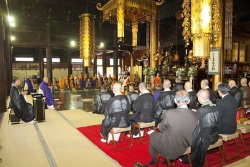Pūrana Kassapa
Pūrana Kassapa: One of the six well known teachers, contemporaneous with the Buddha.
He is said to have taught the doctrine of non-action (akiriya), denying the result of good or bad actions (D.i.52 f); probably the more correct description of Kassapa's teaching would be niskriyavāda - i.e., an affirmation that the soul is passive, unaffected by the good or the bad done by us, the ultimate reality lying beyond good or evil.
Elsewhere (S.iii.69; v.126), however, he is mentioned as an ahetuvādin, denying hetupaccaya (condition and cause - i.e., the efficacy of kamma), which teaching, in the Sāmaññaphala Sutta (D.i.53; see also A.iii.383, where the teaching of Chalabhijātiyo is also attributed to Pūrana), is attributed to Makkhali Gosāla.
Buddhaghosa says (DA.i.142; he could not have been a slave. Kassapa is a brahmin gotta.
The SNA (372) calls him an ājīvaka) that Pūrana Kassapa came by his name from the fact that as a result of his birth the number of slaves in a certain household reached one hundred. Owing to this fact he was never found fault with, even when he failed to do his work satisfactorily. But, in spite of this, he was dissatisfied and fled from his masters.
He then had his clothes stolen by thieves and went about naked. His gotta name was Kassapa.
He had a following of five hundred, among whom was the deva putta Asama (S.i.65, see also Ajātasattu).
He was consulted by the Licchavis Abhaya (S.v.126) and Mahāli (S.iii.68) and by the wanderer Vacchagotta (S.iv.398).
He claimed to be omniscient. (A.iv.428; here we probably have a more correct explanation of his name, Pūrana - i.e., in his claim to have attained perfect wisdom, pūranañānna).
A story in the Dhammapada Commentary (DhA.iii.208)* states that when the heretics were unable to prevent the Buddha from performing the Twin Miracle under the Gandamba, they fled discomfited.
Pūrana Kassapa was among them, and in the course of his flight, he came across one of his followers, a farmer, who was on his way to see him, carrying a vessel of broth and a rope. Pūrana took the vessel and the rope, and going to the banks of the river near Sāvatthi, tied the vessel round his neck and threw himself into the stream.
There was a circle of bubbles on the water and Pūrana was reborn in Avīci. The Milindapañha (p. 4 f) also mentions a Pūrana Kassapa, contemporary with Milinda. This perhaps refers to a teacher descended from the same school who is credited with the view that the earth rules or sustains the world. v.l. Purāna.
- For a different version see Rockhill: op. cit., 80. According to this legend, Kassapa must have died in the sixteenth year of the Buddha's ministry. This is hardly reconcilable with the statement that Ajātasattu consulted him.
